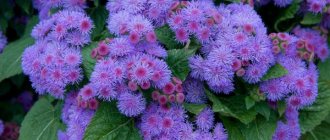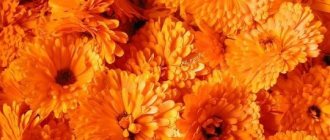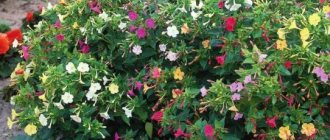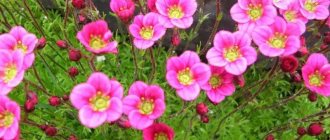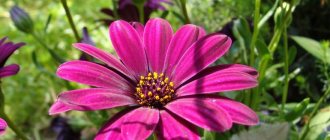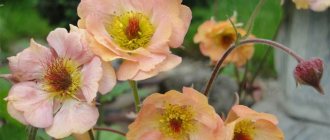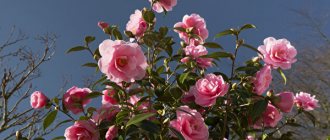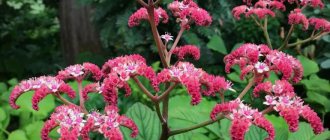Brachycoma is an amazingly unpretentious, long-flowering plant from the Asteraceae family .
The variety of colors, a cap of corollas throughout the season and absolute unpretentiousness make it a real find for any flower garden.
Let's figure out what brachycoma is and how to breed it on your site.
Brachycoma. Description of the plant
The appearance and spread of “wild chamomile” in European gardens is due to the navigator and traveler William Dampier, a famous naturalist in Great Britain. He liked the flower so much that he brought it from Australia and planted it in his garden. In the 19th century, the cultivated Shorthair was a very common garden flower. Later they forgot about her a little. At this time, the popularity of brachycoma is being restored thanks to the breeding developments of new varieties.
Brachycoma is a southern plant. Its natural thickets can be found in Australia, New Zealand and the Tasman Islands. The European name comes from the Greek words brachis and kome, which translated means “small hair”. These short bristles are located on the seeds. Another popular name for the flower sounds like this: “short-haired”. The botanical name Brachyscome was first proposed by the French botanist Alexandre Gabriel in 1816.
Biological description of the culture:
- The height of herbaceous stems is 15-40 cm.
- Flowers are small inflorescences – baskets, from 2 to 4 cm in diameter. Up to hundreds of inflorescences can bloom on one stem.
- Inflorescences of 2 types: marginal and central. The marginal petals are reed-shaped, with a wide range of colors: from white, blue to bright purple or pink.
- The stems of the plant are branched, with delicate, finely dissected leaves.
- The root system is superficial and fragile.
- Cultivated varieties that are suitable for growing in gardens of temperate latitudes are annuals. In its homeland, under natural conditions, brachycoma grows like a perennial.
Brachycoma, planting and care (photos for clarity are presented later in the article), which does not cause much trouble, begins flowering in mid-June and continues to please the eye until frost. At home, under conditions of natural germination, there are about 50 species of this plant.
In the climatic regions of European mid-latitudes, it is possible to grow only 2 species:
- Brachycoma multifidus received the second name “mountain chamomile” for its ability to germinate in mountainous conditions on rocky soils. This species is highly drought-resistant. The height of the stems reaches 40 cm. The leaves are sharp, the flowers are small - white, pink or pale lilac.
- Brachycoma iberolifolia is the most popular species among European gardeners. The variety got its name due to the similarity of the leaves to the Iberis plant. Several varieties of this species have been bred through selection.
A comparison table and description of the most popular ones is presented below:
| Name | Description | Peculiarities |
| Blue Star | The pointed outer petals are pale blue. | The ampelous stems allow this variety to be grown in hanging baskets. |
| Blue baby | The stems are highly branched, up to 25 cm high. Flowers with reed petals, blue. | Suitable for planting in alpine hills and on rocky ledges. |
| Waltz | A mixture of pink, blue and lilac varieties with dark centers. | An ideal variety for borders. |
| Swan Lake | Variety mixture in tones of white, blue and purple. Petals are feathery, dissected. | Very well suited for decorating stone sculptures. |
| Bravo | A variety mixture of white, purple, blue, pink tones. The marginal petals are tubular, bordered at the base. The middle is bright yellow or brown. | The hybrid variety forms a dense, spherical bush. The most popular variety among designers. |
| Margarita | Colors – yellow, pink or lilac. Inflorescences are small star-shaped baskets. The middle is dark. | Strongly branched variety. Used for decorating borders and alpine slides. Suitable for pot growing. |
| Gorgeous | Colors – all shades of blue | It grows very quickly. A good choice for decorating balconies. |
When and how does it bloom
Brachycoma blooms very luxuriantly and up to 100 flowers can grow on one bush at the same time, which allows it to be used to decorate the garden. Each flower variety has a varied range of flowers. The shade can be blue, cyan, white, purple, lilac, pink and violet.
The flower is a basket of inflorescences with a diameter of three centimeters. Petals can be reed or tubular. The plant blooms from early June to September.
To ensure that brachycoma blooms last as long as possible, the bush is regularly pruned, removing dry shoots and wilted inflorescences.
Plant conditions
Brachycoma, planting and care (photos of the plant for clarity are given later in the article), which are similar to similar procedures for flowers of the aster family, is considered unpretentious. If basic agrotechnical measures are observed, it will last throughout the warm period of the year.
Lighting
Brachycoma is a very light-loving plant; the area in which it will grow should be illuminated by the sun throughout the day. Light shading is appropriate in hot weather.
Another requirement is protection from winds and drafts.
Temperature
For seed germination, the optimal temperature is in the range of 16-20o. Despite the fact that the plant likes to be in a sunny area, in extreme summer heat it can dry out. The best temperature conditions are moderately warm, even somewhat cool. In room conditions, brachycoma grows successfully at average room temperatures.
Soil and drainage
The weak root system of brachycoma requires soil with neutral acidity. The soil should be light, nutritious and breathable. Small pebbles, broken bricks or other items suitable for drainage must be added to the soil.
For growing in containers, a universal plant mixture with added drainage is suitable. You should remove weeds around the bush carefully. The superficial root system does not like frequent loosening of the soil.
Watering
The plant does not tolerate waterlogging. The planting site should be chosen in such a way that rainwater does not accumulate in it. In the absence of natural precipitation, watering should be moderate as the top layer of soil dries out. The plant responds well to spraying, especially during hot periods.
Attractive outfit of a majestic flower
Brachycoma iberisolifolia belongs to the perennials of the Asteraceae family. Since it cannot withstand severe frosts, it is grown as an annual crop in the middle latitudes of Russia. Initially, the flower was brought to Europe at the end of the 17th century. And after a few decades, they began to grow it in city flower beds and garden plots.
Translated into Russian, the name of the culture “brachycoma” means “short hair”. However, it is associated with the exotic shape of the seeds and the fluffy decoration on one of its sides.
Today there are many varieties of flowers, but the most popular are considered:
- Bravo;
- Blue Star;
- Mangenta Deline;
- Summer Skies;
- Margarita;
- Blue Baby;
- Waltz.
The flower has an erect stem that branches gracefully at the top of the plant. Narrow leaf plates cut into slices are strung on it. They are distinguished by a refined emerald hue. On each shoot, cute inflorescences are formed in the form of baskets reminiscent of daisies.
They are painted in the following colors:
- pink;
- white;
- blue;
- deep purple.
The diameter of the buds reaches 4 cm. When they bloom, the air is filled with a pleasant aroma. The flowering period lasts from early June to early September. Some bushes are decorated with from 30 to 50 inflorescences.
The petals of Brachycoma iberisolifolia buds can be either single or double in nature.
Methods of cultivation and reproduction
In its places of origin, brachycoma grows as a perennial and can reproduce by seed or vegetative means. In frosty winters, summer young shoots die off, so for the central regions the main method of propagation is by seed. The seeds ripen in the fall after flowering. If they are not collected, they fall to the ground and can germinate on their own next spring. The similarity of the seeds is maintained for 3 years. You should not collect seeds of hybrid varieties (they are marked in the name on the seed packet with the letter F). Plants from them do not retain the characteristics of their mother plants and are not distinguished by lush flowering.
If you want to preserve the mother brachioma bush, you can transplant it into a container in the fall, cut the stems to about the middle and leave it for wintering in a warm room. With the onset of suitable temperatures, the bush is planted back into open ground.
During transplantation, the bush can be divided into 2 or more parts. In the southern regions, they practice wintering brachycoma in open ground. Before cold weather, the stems are cut and covered with leaves or spruce branches. In the spring, when the first fresh shoots appear from the ground, the bush can be divided and replanted. Another method of propagation is cuttings. It is used for propagating hybrid varieties for which the seed method is not suitable.
The end result depends on love and care
Like other flowers, Brachycoma iberisolia needs human attention. Otherwise, it will lose its decorative effect and turn into dense thickets. Therefore, there are a number of simple agronomic rules that are important to adhere to. Since the plant prefers slightly acidic soil rich in minerals, fertilizing is applied regularly. To do this, use ready-made fertilizers from the store. They are added according to the instructions provided on the packaging.
To provide the brachycoma root system with oxygen, the top layer of soil is carefully loosened. Along the way, weeds are also pulled out. The procedure is performed very carefully, trying not to damage the root system and young shoots. Then the soil is sprinkled with sawdust or leaves.
Brachycoma iberisolifolia is not often watered, because its homeland is distant Australia. And it is famous for its long droughts. In addition, the water for irrigation is first heated, leaving the containers in the sun. During the rainy season, the surface of the flower bed where the flowers grow is sprinkled with wood ash. Thanks to this, snails - the most dangerous pests of flowers - will “pass by” the flower bed at their summer cottage.
Due to excessive moisture, the root system of the crop undergoes rotting. Timely transplanting of flowers to a new place will save them from inevitable death.
The decorative beauty of the plant is maintained by pruning. Throughout the flowering season, dry buds are carefully removed from the bushes. To form a stylish crown, pinch the shoots. Annual crops are transplanted into pots in the fall. Thanks to this, they will bloom until the end of the year. This approach is used in cooler regions of Russia.
Violation of the rules of care leads to withering of the crop, yellowing of the leaf blades and premature shedding of the buds.
How to grow a plant: step-by-step instructions
Brachycoma can be grown in flower beds and pots at home.
In the open ground
From sowing seeds to flowering of brachycoma, a period of 70 days is required; the temperature for seedlings should not be lower than 16o. In order for flowers to decorate the garden longer, it is better to grow the plant using the seedling method. Sowing seeds for seedlings is carried out at the end of February - March.
This method is simple and involves the following steps:
- Ready-made soil for sowing can be purchased at gardening stores. A universal soil mixture will do. You can prepare it yourself in advance from leaf soil, turf, sand and humus. Proportions: 1:3:1:2.
- The soil is poured into prepared containers and moistened well.
- The soil mixture in the container is leveled and shallow grooves are made.
- The seeds are evenly distributed over the grooves. There is no need to sprinkle soil on top or press the seeds.
Brachycoma, planting in open ground from seeds - The container is placed under film or covered with glass, left for germination in a place where the required temperature of 16-20o will be maintained.
- The first shoots should appear in about 7 days. After they grow up, the cover can be removed.
- When 2-3 leaf blades appear on the seedlings, a dive is carried out - transplantation into larger containers at a distance of at least 5 cm from each other, or into separate cups. Replanting is done with a small spatula, carefully removing the plant. The main root of the separated seedling is lightly pinched, transferred to a new hole or cup and covered with soil.
- The transplanted sprouts are sprayed with a spray bottle.
- After diving, seedlings do not need shelter. When warm days arrive, the containers are taken out into fresh air for some time to harden.
The brachycoma is transplanted to a permanent location when truly warm days arrive with night temperatures of at least 16°C. Usually in temperate latitudes this is the end of May - beginning of June.
Instructions:
- The first stage of planting will be preparing a place for the southern beauty. It should be a sunny clearing, protected from drafts.
- A hill is better suited for brachycoma than a lowland in which rainwater will accumulate.
- For drainage, the hole under the sprout is filled halfway with drainage material: small pebbles, expanded clay.
- Transplantation is carried out together with a lump of earth. If the seedlings grew in peat cups, then they are planted with them. The interval between plantings is from 20 cm.
- After planting, the seedlings are watered abundantly.
At home
To grow brachycoma in the house, select a pot with a diameter of about 20 cm. The process of preparing the soil mixture and sowing seeds is carried out in the same way as sowing seedlings. Several seeds are placed in a pot, after germination 1-3 of the strongest are left, the rest are removed.
In indoor conditions, brachycoma grows and blooms well if certain conditions are met:
- Regular watering is necessary during the period of active growth, then as it dries out.
- Dried stems and flowers should be removed.
- Weekly fertilizing during watering.
A bush overwintering in the house can be used to grow a new plant from cuttings. To do this, with the onset of spring, several young branches are cut off from the bush and rooted in containers with nutritious, moist soil. Before rooting, the containers are covered with film. With the onset of suitable temperatures, new shoots are planted in open ground or in a pot.
The order of sowing brachycoma seeds
A common way to grow brachycoma is to sow seeds, because in winter the plant dies and there is no way to get shoots.
It is recommended to sow seeds following a certain sequence:
- Prepare the soil for sowing in advance. You can purchase it at a specialty store or prepare it yourself. You need to know: it should be light and fertile. It should include turf, sand, leaf soil, humus and mineral fertilizers.
- Prepare a shallow container. It must be filled with prepared soil and moistened with a spray bottle.
- Draw small grooves and sprinkle the seeds evenly. They cannot be covered with soil or deepened.
- Cover with film and place in a warm place.
Brachycoma in landscape design
Brachycoma is a universal plant for design. Planting and caring for it are simple, which allows you to decorate alpine hills and rocky slopes with flowers of various shades. Balconies and retaining walls decorated with shorthair look impressive. The photo of flower beds with brachycoma shows how well its bushes stand out against the background of other garden flowers.
This plant goes especially well with such garden crops as:
- pelargoniums;
- marigold;
- petunias;
- zinnia;
- garden bells;
- fragrant tobacco.
To combine with brachycoma, any type of flower with large, rough buds is suitable for contrast. Islands of brachycoma bushes of different varieties and colors collected together look extremely attractive. The stems lend themselves well to shaping.
With light pruning, the bush can be given any desired shape. Pinching the top will give the bush fullness, and timely removal of dried flowers will prolong the flowering time. Delicate brachycoma balls are appropriate in any garden compositions. She decorates borders and borders equally charmingly. It can grow in separate containers and in flower beds.
Application in the garden
In the garden, Brachycoma iberisolifolia can have many uses:
- Its dense shape and delicate, lacy leaves make it ideal for covering empty spaces in flower arrangements after spring bulbous plants bloom.
- Can act as a border for paths and lawns.
- Looks great in rock gardens and gravel gardens.
- Combines well with other low shrubs (thyme, dwarf barberry, wolfberry).
- Looks beautiful with evergreen iberis, lobelia erinus, whorled coreopsis, daylilies.
- Excellent for growing in climatic rural, romantic, naturalistic and English gardens.
- Can be grown in boxes, hanging pots on balconies, terraces. Over the course of the season, brachycoma will create a beautiful, green, lacy cascade of many bright flowers hovering above the leaves like a colorful cloud, hanging slightly over the sides of the container. Will create beautiful compositions with other balcony plants - garden verbena, Lobelia Erinus, string, bacopa and petunias.
Brachycoma is a very fashionable seasonal plant lately for planting in flowerbeds, pots and cache-pots. It is quite unpretentious and blooms all summer until frost, so it can be used as the main plant, supplementing pots with other flowers. Looks better in combination with other balcony and terrace plants. It can also be used for borders and rock gardens.
Pest and disease control
All varieties of brachycoma are resistant to diseases and pest infestation.
However, under unfavorable weather conditions or non-compliance with agrotechnical cultivation rules, signs of certain diseases may appear:
- With fusarium, rotting begins from the root. The stems become limp and thin, the leaves turn yellow and fall off.
- Powdery mildew appears as a white coating on the upper leaves, which turn brown over time.
- Rust is caused by fungal spores that form brown spots and bumps on the undersides of leaves.
- Gray mold forms during periods of prolonged rains and high humidity. The leaves become covered with dark brown spots and a coating of gray mold.
The main control against diseases is spraying with fungicides. Diseases are easier to prevent than to treat, so in rainy weather it is better to treat healthy plants for preventive purposes several times every 10 days. Bushes affected by gray rot are removed from the site. Creeping and flying pests can cause some damage to flowers.
Snails and slugs
They leave sticky marks and holes on the leaves.
Fighting them:
- Physical methods involve manual collection of pests.
- Traditional methods include sprinkling plants with dry mustard, red pepper, and crushed tobacco. You can prepare the following composition: mix wood ash, baking soda and tobacco dust in equal quantities.
- Spraying with special preparations (for example, Anti-slug, Meta, copper preparation).
Aphid
Colonies of this small insect infect all surface parts of the plant. As a result, the leaves become sticky and curl, the buds and flowers wither and dry out.
This pest is controlled using chemical treatments:
- sulfur powders;
- green potassium soap;
- Fitoverm;
- Actellik.
Natural remedies to combat aphids are carried out by spraying infusions:
- marigolds;
- tobacco with dandelion;
- Luke;
- yarrow;
- tansy.
Affected plants are sprinkled with wood ash and sprayed with nettle infusion.
Thrips
Small pests that attack leaves feed on plant sap. Yellow spots and brown dots appear on the leaf blades on the underside. As a result, the leaves dry out and fall off.
In addition to special chemicals, the following methods are used:
- the affected plants are treated with a soap solution;
- increase air humidity by daily spraying;
- spray with infusion of tobacco and yarrow.
- Treatment with a decoction of cyclamen roots.
Whitefly
A flying insect with white wings strikes the shorthair very rarely. Damage to the plant is caused by its caterpillars, which feed on the leaves. If such an attack does happen, then the only salvation will be treatment with fungicides.
Planting and care
For Brachycoma iberisolifolia and its varieties, choose only well-lit areas with permeable, moderately moist, nutritious soil with a sufficient sand content. There should be no excess moisture in the permanent growing area. The site must also be protected from strong winds and constant air currents.
The growing area must be dug to a depth of 20-25 cm and carefully leveled. Plants are planted so that there is from 15 to 20 cm between them. Brachycoma grows quite quickly and forms a continuous carpet of shoots and flowers.
Caring for this crop does not require any special knowledge or effort. Plants are watered infrequently, as the soil dries out. In the central zone of our country it is needed only in hot and dry times. In the southern regions, watering should be regular, since a severe lack of moisture reduces flowering time and its splendor. It is worth remembering that severe drying out of the soil can lead to the death of brachycoma.
To maintain abundant flowering, the bushes are pruned and the cuttings are used for rooting. Cut parts of shoots 8-12 cm long easily form roots in a short time in sandy soil.
Brachycoma iberisolifolia is practically not affected by any diseases or pests. Only in years with strong temperature changes in hot weather can powdery mildew appear, more information about the fight against which can be found here.
To combat this disease, fungicides are suitable: “Skor”, “Topaz”, “Topsin” and others. You can also use biofungicides: “Fitosporin-S”, “Planriz”. Prevention of this disease is the correct growing technology, which includes fertilizing with phosphorus and potassium fertilizers. Such fertilizing increases plant resistance to diseases.
Sometimes this species attracts the attention of snails, which feed on the leaves with great pleasure. To destroy these pests, use garlic or mustard infusion, as well as the preparations “Thunder” and “Thunderstorm”.
Why does the plant dry out and the leaves turn yellow?
Brachycoma, planting and care (photos of the plant are presented in the article for general information), which is not difficult even for novice gardeners, is sensitive to unsuitable weather conditions.
The leaves on the bushes have turned yellow, in reality there are all signs of drying out - there may be several reasons for this phenomenon:
- Although brachycoma does not like abundant watering, during periods of intense heat and lack of rain, the flowers lack moisture in the soil and in the air. It is necessary to increase watering and spraying.
- Excess of organic or mineral fertilizers.
- Thrips infestation.
Growing brachycoma from seeds
Brachycoma seeds are sown indoors 6-8 weeks before the expected last frost. Sowing is carried out superficially or the seeds are covered with a very thin layer of earth, no more than 1 millimeter. This is due to the fact that brachycoma requires light to germinate.
Seeds germinate quickly, from 2 to 12 days; commercial seeds most often germinate in 2 to 4 days. Seeds can also be sown directly in the garden after the last frost. You can also sow the seeds in midsummer for fall blooms. Some gardeners prefer to sow brachycoma seeds every two to four weeks throughout the summer to extend flowering throughout the season.
Brachycoma seedlings are planted in the ground after the last frost. Planting pattern: 15x20 cm. Pinching the tips early in the season will result in bushier plants.
Possible difficulties in growing
Brachycoma (planting and care, photos of which are presented step by step in the article, are not difficult) is generally characterized as a hardy and disease-resistant plant.
Possible difficulties may be associated with atypical weather conditions or violation of agricultural practices:
- Too rainy summers or excessive watering can lead to rotting of the roots or stem. To prevent this from happening, you need a good drainage layer and rocky soil. A rotten plant can be saved if the rot has not spread to the entire root. To do this, it needs to be transplanted to another drier place, having first removed all the affected parts.
- Brachycoma can become infected with certain diseases or pests from other diseased plants.
- Too much shade has a negative effect on the growth and flowering of the plant.
- Difficulties in growing from seeds can only be associated with a violation of technology or poor quality of seed material.
Cultivation rules
According to gardeners, growing brachycoma is not a problem. The bush looks decorative even if there is no constant care for it, so the crop can be grown in dachas where the owners rarely visit. But in order for it to reveal its full potential and become a real decoration of the site or yard, you should adhere to the basic rules.
Watering
Brachycoma tolerates dry periods well, so it is recommended to water it only when there is no rainfall for more than 2 weeks, and the heat is more than 30°C. It is better to moisturize rarely, but plentifully. River or rain water is ideal for irrigation, as it contains no chlorides. Experts advise watering the garden bed in the morning or evening after sunset so that direct sunlight cannot leave burns on the leaves.
Fertilizing
It is recommended to fertilize brachycoma three times. At the same time, different complexes are used in different periods:
- The first feeding is 2-3 weeks after planting the seedlings in a permanent place. It is necessary to use a complex with a high nitrogen content, but the solution is made 2 times weaker than what is written in the instructions. This fertilizing will help quickly increase green mass and make the bush thicker.
- The second feeding is after the first buds appear. To do this, use a complex for surfinias or petunias in half the concentration.
- The third feeding is about a month after the start of flowering. Full dosage can be used. This fertilizer will give strength for the continuous appearance of buds.
Instead of flowering complexes, you can use wood ash, which is scattered over the surface of the soil before watering.
Loosening
This procedure will be necessary for care at first, when there is empty space between neighboring bushes. Weeds can grow on it, which take away nutrients from the brachycoma. To prevent this from happening, it is recommended to carry out weeding in a timely manner. This will also allow you to break the crust on the surface, which remains after the soil dries and prevents air from reaching the roots. It must be remembered that the root system of the plant is superficial; there is no need to deepen the tip of the tool excessively, otherwise the underground organs may be damaged.
You can mulch the bed immediately after planting. This will simplify care and cultivation, since a crust will not form after rains, the soil will dry out more slowly, and weed seeds will not germinate.
Where to buy and cost of the plant
The popularity of garden brachycoma has increased again, so you can purchase seed material at all retail outlets that sell seeds. A bag of 0.5g (that’s about 2000 seeds) costs 12-25 rubles. Some nurseries offer the sale of ready-made seedlings that only need to be transplanted into a pot or flowerbed. The cost of one plant is about 150 rubles.
Agricultural companies practice selling seeds, seedlings and seedlings through online stores. Photos of brachycoma on the pages of magazines describe all the tenderness of the Australian Shorthair. The ease of planting, ease of care, and the versatility of this plant in design are returning it to its former popularity, which was temporarily undeservedly lost.
Popular types
Studying photos of brachycomas, we can distinguish several main types:
- Iberisolifolia. A shrub with a branched stem from which small, rich green leaves emerge. It reaches a height of about 40 cm. The foliage is arranged in 2 rows and frames a black basket. The color of the leaves ranges from pink to purple.
- Multipartite. The maximum height of the bush is 40 cm. The foliage can be either elongated or dissected. Prefers rocky soils.
Sowing in open ground
You can do without growing seedlings. The key to good plant health is the right location. The soil should be loose, nutritious, and well moistened. First, it is carefully dug up and leveled. Sow in strips 5 cm wide, sprinkle with a very thin layer of sand (no more than 1 cm). Between rows maintain a distance of about 15 centimeters.
Attention! Soil moisture is the main important indicator for the development and growth of seedlings.
If in the future it is not planned to plant young growth or move plants to another place, then it is better to thin out the seedlings. The optimal distance is 20 cm.
Choosing a site for planting, soil
The best area for growth will be the southern part of the garden, preferably in an open clearing where there is a lot of sunlight. It’s even better to plant plants along its perimeter, building something like a “fence.” It also feels good if it is occasionally in partial shade during the day. However, the planting area should under no circumstances be covered by buildings or trees. The presence of drafts or constant strong winds is also unacceptable.
There are no special requirements for the composition of the soil. If the soil is poor, you can add compost to it. If you try to please the Australian beauty, it is preferable to create a substrate similar to a mixture for seedlings. It is desirable to have a slight acidity, and the soil must also be very loose, so that excess water does not accumulate, but seeps out and goes deeper faster.
Plant care (watering, fertilizing)
The pet does not require any special conditions for itself. In order for it to please you with abundant flowering, you must follow a number of simple rules:
- The plant can withstand several days of dry weather, but excessive watering causes fungal diseases of the root. It works best to spray the flowers with a hose twice a day. And be sure to loosen the soil more often. Then the moisture will pass through its thickness faster. Abundant watering is required only for young animals during the period of intensive growth; the rest of the time, moderate watering once a week is sufficient.
- Feeding. It is better to use mineral fertilizers. 3-4 times per season is enough. It is not recommended to use manure and other organic matter. The flower garden will not appreciate this.
- Weeding and loosening also help saturate the root system with oxygen.
- Remove dried shoots and leaves in a timely manner. This gives strength for more magnificent flowering.
- Bush formation. If you pinch the top, you can give it a beautiful spherical shape as the plant begins to branch.
Attention! If the winters are mild and warm (for example, in the south of Russia), then you can try leaving the bush until spring, having previously insulated it. To do this, all dry parts are cut off, the frame is covered with straw and spruce branches.
